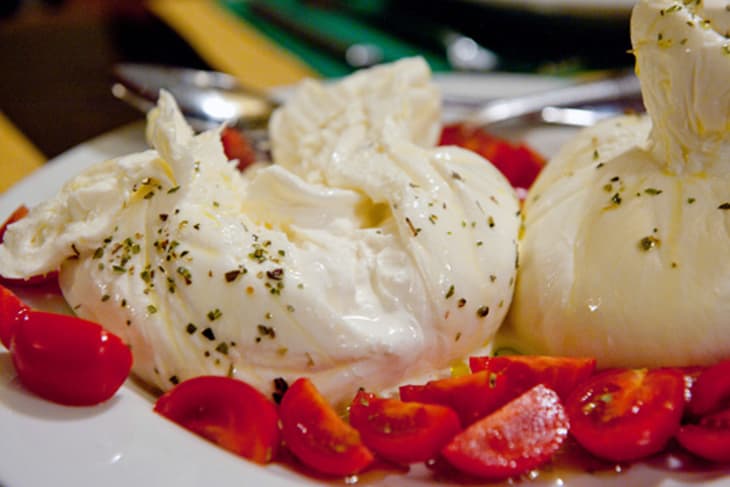The Uncanny Tastiness of Burrata: It’s That Good
Burrata means “buttered” in Italian. It’s that rich. What it really is, though, is fresh cheese at its best. At first glance, burrata resembles a ball of mozzarella. But upon further scrutiny, it’s clear that this round of cheese is softer, and indeed, when cut, has an interior that spills out, revealing soft, stringy curd and fresh cream. If you’re a lover of mozzarella, ricotta, or really anything that’s straight-up creamy, this cheese is so what you want.
Let’s get one thing clear: Burrata is not mozzarella. And burrata is not buffala mozzarella, although it’s made from buffalo milk. Burrata is its own thing entirely, and you’ll know this the second you taste it. Perhaps some of the confusion has come from its tradition, which tells of a cheesemaking process that was born from another: burrata was made in order to rescue the little scraps of mozzarella di bufala that were leftover in the cheesemaking vat.
In understanding the makeup of burrata, however, it’s helpful to summarize a bit of what we know about mozzarella. Mozzarella is what’s called a pulled curd or pasta filata cheese, which means that it’s formed from the elastic curd of fresh milk, still warm and straight from the vat. Burrata is made of that same stringy cheese, but is formed not into a solid ball, but into a little hollow pouch, which is then filled with fresh cream and soft stringy bits of curd, the ritagli, or rags, remaining after mozzarella making. It’s all tied off at the top, and then wrapped in the fronds of an Italian plant called asphodel (a relative of the leek).
The thin sheath of mozzarella (the closest thing that burrata has to a rind) should be incredibly supple and yielding — just thick enough to prevent the cream-filled middle from spilling out. If it’s chewy and rubbery, your burrata may be a bit older; as with all fresh cheeses, the fresher the better. But what you’re really going for in the end, has nothing to do with that exterior, really. It’s all about what lies within. Thick, spreadable strings of cream, with a slightly sour finish. Also of note is that buffalo milk is richer and higher in butterfat than cow milk. (Never a bad thing.)
I’ve talked about burrata before, but that was years ago. When burrata first started coming into the country, distribution was spotty, shipping was expensive, quantities were low because demand was so high, and quality wavered. Now, it seems as though its import is down to a science, and I’ve recently been tasting some of the best burrata I’ve ever had.
While burrata originates from Puglia, and anything imported will be from that region of Italy, I’ve started tasting versions made in-house at restaurants. Needless to say, I’m hoping it’s a trend that will catch on. Eat burrata plain, of course, and on bread, but also try it in salads and pastas, atop pizzas and soups, and as dessert. You’d never suspect that it was once meant to be left behind.
Nora Singley is an avid lover of cheese, and for some time she was a cheesemonger and the Director of Education at Murray’s Cheese Shop in New York City, where she continues to teach cheese classes for the public. She is currently an assistant TV chef on The Martha Stewart Show.
Related: Recipe: Heirloom Tomato and Burrata Salad
(Images: Flickr member star5112 licensed for use under Creative Commons; Nora Singley)
